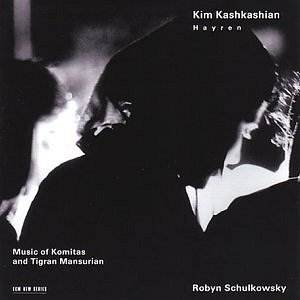I have never heard a record by the Armenian viola
player Kim Kashkashian which was anything less than interesting
and this proves to be no exception. Manfred Eicher's ECM label
continues to stimulate, educate and more, this time with a foray
into the historic and contemporary musics of Armenia, with thankfully
not a Sabre Dance in sight! It pairs two pieces for viola and
percussion by living Armenian composer Tigran Mansurian with some
of his arrangements of the songs of the legendary folk-music collector
and priest Komitas, born Soghomon Soghomonian but renamed after
a 7th century hymn writer. Steve Lake's booklet note
on Komitas is supremely interesting, touching on related subjects
as diverse as Gurdjieff and the Armenian genocide by the Turks.
Musicweb readers may be familiar with him as a formative influence
on the great Armenian-Scottish composer Alan Hovhaness.
I have, perhaps not surprisingly, never been
to Armenia but for various reasons it is a country that has held
a place in my consciousness for many years, from a schoolboy's
fascination with the far-off, exotic and remote, fed by obscure
travelogues borrowed from the library, to the moment when, ten
years after Blixa Bargeld and Einstürzende Neubauten first
recorded it, "Armenia" screamed from the soundtrack
of Michael Mannís Heat - "Are the volcanoes still active?".
Later, visiting the Armenian quarter in Jerusalem, I learned about
the genocide, and was subsequently greatly moved by the haunting
liturgy of the Armenian Church. Now this superb disc reawakens
that latent interest.
The two Mansurian pieces played by Kashkashian
and expert percussionist and ECM stalwart Robyn Schulkowsky bookend
the disc. The opening Havik is relatively short but packs
great emotional punch into its five minutes and its melancholy
lyricism is gripping. The closing Duet is much longer,
more abstract and requires more intent listening if its inner
depths are to be penetrated but it is well worth the effort. The
Komitas settings are fascinating, not least for Mansurian's piano
and almost whispered, quavering vocals, the latter apparently
baring little resemblance to Komitas' own celebrated baritone.
However, the effect is of emotions laid bare - whether the arrangements
are reduced to a solo piano or expanded to encompass viola, percussion,
piano and voice - some pieces are also repeated in different instrumentations.
The overriding impression is one of deep but understated lamentation
and it is all strangely very uplifting. I eagerly devoured not
only the music but the whole superb package which includes as
well as Steve Lake's essay, an equally fascinating one by the
composer explaining the genesis of the disc, which included a
pivotal concert in Bergen with Jan Garbarek, and the beautiful
prose and poetry of Ossip Mandelstam, plus many atmospheric photographs
of the performers and Komitas himself. I don't get to hear as
many ECM discs as I would like but this reminds me very much of
what drew me to the visionary label in the first place. I suppose
it is inevitable comparisons will be drawn with the Georgian composer
Giya Kancheli, also an ECM favourite, but although the music shares
some of the atmospheres and inflections it is much more intimate
and smaller scale than Kancheli's large canvasses tend to be.
I am very glad to have made the acquaintance
of the music of Mansurian and Komitas, particularly via such an
inspired artist as Kim Kashkashian. Havik, Hoy, Nazan
and Garun a, in particular, are pure poetry, in keeping
with the meaning of the disc's title Hayren. I do urge
you to give this a try - ECM aficionados will probably know more
or less what to expect, as would keen Hovhaness listeners. If
you like the more melodic Bartók, the more oriental Vaughan
Williams or maybe the Celtic inspirations of Peter Crossley-Holland
I reviewed recently, then this may also appeal. Much of the music
is slow and quiet but still burns with a very intense flame.
Neil Horner
